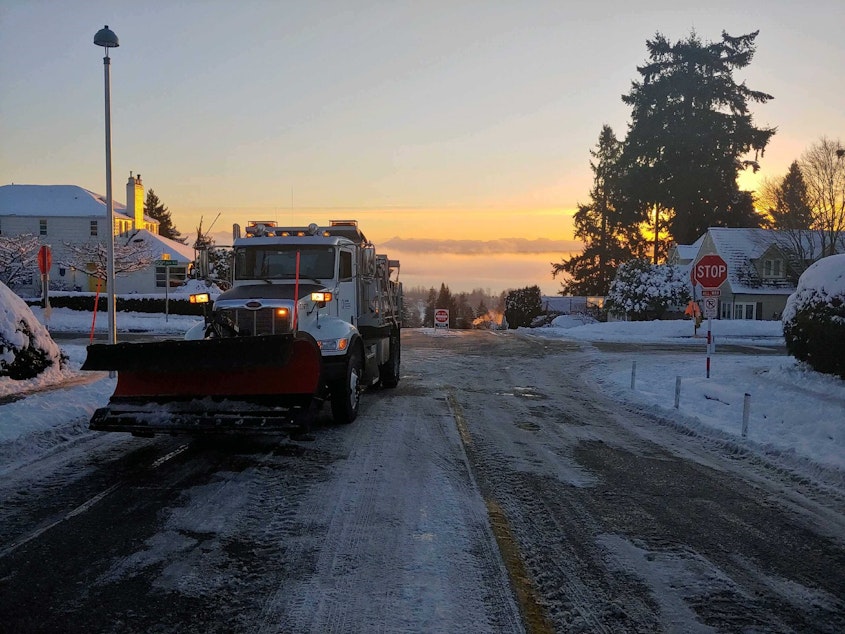Why salt became king in Seattle snowstorms

Road crews have fought the Seattle area snowpocalypse with salt — despite its many well-known downsides.
“There’s quite a long list,” said Professor Xianming Shi, of Washington State University.
For one, what it does to your car, which Darlene Feikema of Shoreline attested to as she shoveled her driveway. “It doesn’t show up immediately," she said. "But it corrodes the car, rusts it out.”
Feikema said that she saw the havoc salt could wreak growing up in Michigan. “If you trade in your car every year, you may not care," she said. "But some of us like to keep our cars longer."
It's also not great for pets; veterinarians recommend wiping or rinsing off dogs’ paws after they walk near salt-treated roads.
Sponsored
Road salt also pollutes waterways and groundwater and shortens the lifespan of asphalt and concrete infrastructure.
And yet, Seattle officials have touted how much, not how little, salt road crews have been applying.
In recent weeks, Seattle road crews applied hundreds of tons of salt and thousands of gallons of brine.
Washington state and Seattle transportation officials declined to say how much salt their crews have applied while their agencies cope with the aftermath of recent winter storms.
Not doing enough to clear wintry roads — or at least having voters think that — has proved dangerous to various politicians’ careers in the past.
Sponsored
In a big snowstorm in 2008, Seattle applied sand rather than rock salt for environmental reasons. Icy chaos ensured, and Mayor Greg Nickels said soon after that the city would switch to salt.
But it was too late, apparently: Nickels lost his job a few months later as voters turned him out of office in the spring primary.
A year later, the city added brine—a watery solution of a different kind of salt and magnesium chloride—to its toolkit.
Since then, the Seattle Department of Transportation has treated roads before snowstorms by spraying brine on them, and then salting them later.
"Pre-treating prevents the ice from building up, which means you have to use less salt down the road,” said spokesman Ethan Bergerson of Seattle Department of Transportation.
“It’s a lot more effective,” Professor Shi said. “You end up using less chemicals to achieve the same level of service on the pavement.”
Shi said winter storms put transportation agencies in a difficult position as they try to meet multiple objectives. “Safety is one of them, but there’s also environmental stewardship, infrastructure preservation, fiscal responsibility, just to name a few," he said.
The main eco-strategy favored by many road agencies today is to use less salt, whether by applying brine before or by carefully monitoring and adjusting how much salt is used.
Sponsored
Temperature and other conditions affect how much salt is necessary to melt ice. “Smart snowplows” include sensors that measure pavement temperature and leftover salt residues in real time to avoid over-application of the harmful, yet beneficial crystals.
Washington State Department of Transportation spokesperson Bart Treece said his agency uses pre-moistened salt: It’s more likely to stick to the road than bounce away uselessly when sprayed from a moving truck.
Seattle-area drivers, roads and fish are at least fortunate that roads rarely need to be de-iced here. Freshwater lakes in snowy regions of the Northeast and the Midwest have turned gradually salty.
Ecotoxicologist Jen McIntyre with Washington State University-Puyallup said the bottoms of some lakes near roadways in Ontario, where she grew up, are now caked with a layer of road salt.
Impacts of salt on freshwater ecosystems are less well-studied in the temperate Pacific Northwest.
Sponsored
“The one time I collected runoff after a salting on [state Route] 520, it had the highest zinc I have observed in a road runoff sample and was lethal to aquatic invertebrates,” McIntyre said by email. Zebrafish eggs in her laboratory were less likely to hatch after being exposed to the salty 520 runoff.
Road salt is mostly sodium chloride — table salt, essentially — but it can act to mobilize heavy metals like zinc, which are often found in roadside soils and can be highly toxic to aquatic life.
McIntyre speculated that young salmon in freshwater streams can handle an occasional pulse of salty runoff. But she said, where salting is a common practice, it can be “terrible for receiving waters.”
Researchers have been looking into eco-friendly deicers made from beet and barley residue and high-tech pavement with nanoparticles added to make it less likely to ice up.
Those innovations, if they do become widely available, are likely to be more expensive than simple rock salt and perhaps most useful for specialized applications like airport runways.
For now at least, on winter roads, salt is king.




